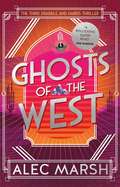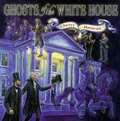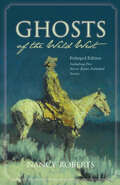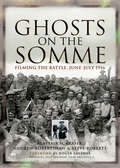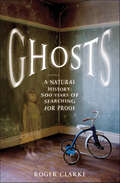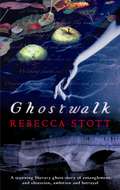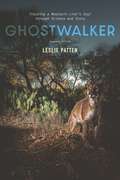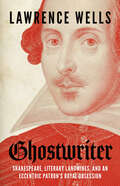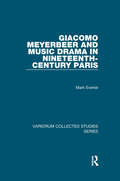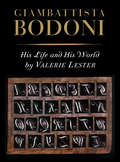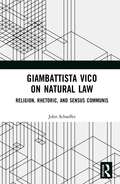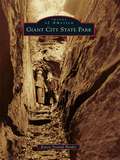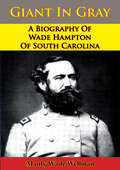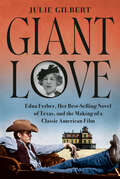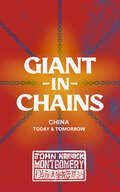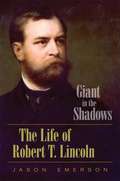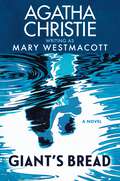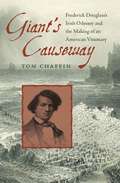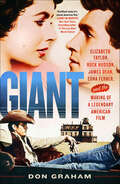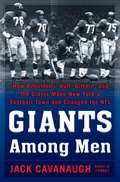- Table View
- List View
Ghosts of the West: Don't miss the new action-packed Drabble and Harris thriller!
by Alec MarshThis third novel in the Dabble and Harris thrillers is perfect for fans of action-packed, historical fiction.'A rollicking good read' IAN RANKINWhen daring journalist Sir Percival Harris gets wind of a curious crime in a sleepy English town, he ropes in his old friend Professor Ernest Drabble to help him investigate.The crime is a grave robbery, and as Drabble and Harris pry deeper, events take a mysterious turn when a theft at the British Museum is soon followed by a murder.The friends are soon involved in a tumultuous quest that takes them from the genteel streets of London to the wide plains of the United States. What exactly is at stake is not altogether clear - but if they don't act soon, the outcome could be a bloody conflict, one that will cross borders, continents and oceans...Meanwhile, can Drabble and Harris's friendship - which has endured near-death experiences on several continents, not to mention a boarding school duel - survive a crisis in the shape of the beautiful and enigmatic Dr Charlotte Moore?Praise for Alec Marsh's Drabble and Harris thrillers...'An immensely readable treat!'ALEXANDER MCCALL SMITH'Told with humour and flair, Enemy of the Raj is a highly enjoyable, riveting read'ABIR MUKHERJEE'A thoroughly engaging and enjoyable diversion'NEW STATESMAN on Enemy of the Raj'Tremendous stuff! With the arrival of Alec Marsh's first Drabble and Harris thriller, John Buchan must be stirring uneasily in his grave'STANLEY JOHNSON
Ghosts of the White House
by Cheryl HarnessGeorge Washington's ghost pulls a girl out of her school White House tour and takes her on a personal tour of the building, introducing her to the ghosts of previous presidents and to the history of the White House and the United States.
Ghosts of the Wild West
by Nancy RobertsSeventeen tales of untamed spirits in the newly expanded edition of the Spur Award finalist from the “custodian of the twilight zone” (Southern Living).In these seventeen ghostly tales—including five new stories—Roberts expertly guides readers through eerie encounters and harrowing hauntings across Kansas, Montana, Wyoming, Colorado, Arizona, New Mexico, Texas, and the Dakotas. Along the way her accounts intersect with the lives (and afterlives) of legendary figures such as Wild Bill Hickok, Wyatt Earp, Bat Masterson, and Doc Holliday. Roberts also justifies the fascination among ghost hunters, folklorists, and interested tourists with notoriously haunted locales such as Deadwood, Tombstone, and Abilene through her tales of paranormal legends linked to these gunslinger towns synonymous with violence and vice in Western lore. But not all of these encounters feature frightening specters or wandering souls. Roberts also details episodes of animal spirits, protective presences, and supernatural healings.Forever destined to be associated with adventure, romance, and risk taking, the Wild West of yore still haunts the American imagination. Roberts reminds us here that our imaginations aren’t the only places where restless ghosts still roam.“Tales of vaporous ghost lights, haunted mesas, phantom gunmen, and reanimated skeletons. It’s a book sure to please collectors of Western lore, fans of well-told, old-fashioned ghost tales and, it would seem to me, school librarians looking for just the right book to introduce middle school and high school readers to American folklore.” —Michael Norman, author of Haunted Heartland
Ghosts of the Yadkin Valley (Haunted America)
by R. G. AbsherGhostly footsteps, mysteriously locked doors, and apparitions from centuries past. The rolling hills and hollers of the Yadkin Valley have been home to many historic events, from Stoneman's raid to the hanging of Tom Dooley. These events have left their imprint on the county's architecture and landscape, and some of them have evenleft a ghostly legacy. Ghosts of the Yadkin Valley is a collection of spine-tingling tales, including ghost stories from many of the area's National Historic Register sites. Join local storyteller R.G. Absher as he relates the history behind the haunts.
Ghosts on the Somme: Filming the Battle, June–July 1916
by Steve Roberts Andrew Robertshaw Alastair H. FraserThe Battle of the Somme is one of the most famous, and earliest, films of war ever made. The film records the most disastrous day in the history of the British army—1 July 1916—and it had a huge impact when it was shown in Britain during the war. Since then images from it have been repeated so often in books and documentaries that it has profoundly influenced our view of the battle and of the Great War itself. Yet this book is the first in-depth study of this historic film, and it is the first to relate it to the surviving battleground of the Somme.The authors explore the film and its history in fascinating detail. They investigate how much of it was faked and consider how much credit for it should go to Geoffrey Malins and how much to John MacDowell. And they use modern photographs of the locations to give us a telling insight into the landscape of the battle and into the way in which this pioneering film was created.Their analysis of scenes in the film tells us so much about the way the British army operated in June and July 1916—how the troops were dressed and equipped, how they were armed and how their weapons were used. In some cases it is even possible to discover what they were saying. This painstaking exercise in historical reconstruction will be compelling reading for everyone who is interested in the Great War and the Battle of the Somme.
Ghosts: A Natural History: 500 Years of Seaching for Proof
by Roger ClarkeA New York Times Book Review Editor's ChoiceA comprehensive, authoritative and readable history of the evolution of the ghost in the west, examining the behavior of the subject in its preferred environment: the stories we tell each other."Roger Clarke tells this [the story that inspired Henry James' The Turn of the Screw] and many other gloriously weird stories with real verve, and also a kind of narrative authority that tends to constrain the skeptical voice within... [An] erudite and richly entertaining book." —New York Times Book ReviewNo matter how rationally we order our lives, few of us are completely immune to the suggestion of the uncanny and the fear of the dark. What explains sightings of ghosts? Why do they fascinate us? What exactly do those who have been haunted see? What did they believe? And what proof is there?Taking us through the key hauntings that have obsessed the world, from the true events that inspired Henry James's classic The Turn of the Screw right up to the present day, Roger Clarke unfolds a story of class conflict, charlatans, and true believers. The cast list includes royalty and prime ministers, Samuel Johnson, John Wesley, Harry Houdini, and Adolf Hitler. The chapters cover everything from religious beliefs to modern developments in neuroscience, the medicine of ghosts, and the technology of ghosthunting. There are haunted WWI submarines, houses so blighted by phantoms they are demolished, a seventeenth-century Ghost Hunter General, and the emergence of the Victorian flash mob, where hundreds would stand outside rumored sites all night waiting to catch sight of a dead face at a window.Written as grippingly as the best ghost fiction, A Natural History of Ghosts takes us on an unforgettable hunt through the most haunted places of the last five hundred years and our longing to believe.
Ghostwalk
by Rebecca StottA stunning literary ghost-story of entanglement and obsession; ambition and betrayal - set in present-day Cambridge, but entangled with the 17th centuryThe son of a reclusive historian finds his mother's drowned body in the tributary of the River Cam that runs through her garden. She is clutching a glass prism. Elizabeth Vogelsang's magnum opus, a book on Isaac Newton's alchemy, is incomplete. Lydia Brooke, a writer friend of the dead historian, returns to Cambridge to the funeral. It is five years since she has seen Elizabeth's son, Cameron Brown, with whom she has had an intermittent love affair that began years earlier. Cambridge, she discovers, is in the midst of an upsurge of attacks by animal rights extremists. Cameron, who, as a neuroscientist uses animal experimentation, has been targeted. Cameron asks Lydia to act as a paid ghostwriter in the completion of his mother's book, Alchemist. Lydia agrees to the proposal and moves into Elizabeth's strange house, a triangular shaped studio on the banks of the Cam. Soon Lydia finds herself entangled, not only with Cameron, but also with a four-hundred year-old murder mystery, a network of 17th century alchemists and a ghostly figure intent on disrupting her work.
Ghostwalk: A Novel
by Rebecca StottA stunning literary ghost-story of entanglement and obsession; ambition and betrayal - set in present-day Cambridge, but entangled with the 17th centuryThe son of a reclusive historian finds his mother's drowned body in the tributary of the River Cam that runs through her garden. She is clutching a glass prism. Elizabeth Vogelsang's magnum opus, a book on Isaac Newton's alchemy, is incomplete. Lydia Brooke, a writer friend of the dead historian, returns to Cambridge to the funeral. It is five years since she has seen Elizabeth's son, Cameron Brown, with whom she has had an intermittent love affair that began years earlier. Cambridge, she discovers, is in the midst of an upsurge of attacks by animal rights extremists. Cameron, who, as a neuroscientist uses animal experimentation, has been targeted. Cameron asks Lydia to act as a paid ghostwriter in the completion of his mother's book, Alchemist. Lydia agrees to the proposal and moves into Elizabeth's strange house, a triangular shaped studio on the banks of the Cam. Soon Lydia finds herself entangled, not only with Cameron, but also with a four-hundred year-old murder mystery, a network of 17th century alchemists and a ghostly figure intent on disrupting her work.
Ghostwalker: Tracking a Mountain Lion's Soul through Science and Story
by Leslie PattenLeslie Patten had seen grizzly bears, wolves, coyotes, deer, elk, and many other species in her years living next to Yellowstone National Park. Yet, like most visitors, she had never seen a mountain lion—the charismatic yet enigmatic predator also known as a cougar, panther, or puma. She had only detected their ethereal presence on the landscape, which left her pondering where they were and what they were up to. After five years, through her serendipitous encounters with their tracks and scat, the burning question remained: What is the essence of the mountain lion? To understand an animal no one sees, Patten conducted more than one hundred interviews with biologists, conservation groups, state wildlife managers, houndsmen, and professional trackers. Slowly, a picture of the lion&’s elusive nature emerged. Ghostwalker presents a complete picture of mountain lions in the West today, uncovering the intimacies of their secretive lifestyle as well as the issues they face in our changing world.
Ghostwriter: Shakespeare, Literary Landmines, and an Eccentric Patron's Royal Obsession
by Lawrence WellsPart literary mystery, part an examination of what constitutes fiction versus reality, Ghostwriter is based on the true story of author Lawrence Wells, then 45, hired by the University of Mississippi in 1987 to ghostwrite a novel for a wealthy, eccentric donor (“Mrs. F,” then 75), who was convinced that Edward de Vere, 17th Earl of Oxford, was William Shakespeare. Believing herself to be the reincarnation of Queen Elizabeth I, Mrs. F treated ghostwriter Wells as a “captive” Edward de Vere.Their roller-coaster literary collaboration dramatized Elizabeth and de Vere’s romance, which according to legend produced a son (Henry Wriothesley) born in secret. Henry grew up to become the 3rd Earl of Southampton, who is universally acknowledged as “The Fair Youth” of Shakespeare’s sonnets and whose real-life descendants include Princess Diana and her sons, Prince Harry and William, Prince of Wales.Wells and his late wife, Dean Faulkner Wells, niece of William Faulkner, traveled to England to research the life of Edward de Vere and interview proponents of the Shakespeare authorship debate. That summer, London tabloids headlined the royal breakup of Prince Charles and Princess Diana, incidentally echoing Wells and Mrs. F’s tempestuous love story about Edward de Vere and Queen Elizabeth I.Flashbacks weave several elements together—the seventeenth-century mystery of Queen Elizabeth’s “royal bastard,” Wells’s evolving relationship with his eccentric patron, his search for the “real” Shakespeare, and the bawdy Elizabethan narrative he composed for his benefactor. The stories merge, leading to a surprising conclusion.
Ghouls, Gimmicks, and Gold: Horror Films and the American Movie Business, 1953-1968
by Kevin HeffernanThe Creature from the Black Lagoon, the Tingler, the Mole People--they stalked and oozed into audiences' minds during the era that followed Boris Karloff's Frankenstein and preceded terrors like Freddy Krueger (A Nightmare on Elm Street) and Chucky (Child's Play). Ghouls, Gimmicks, and Gold pulls off the masks and wipes away the slime to reveal how the monsters that frightened audiences in the 1950s and 1960s--and the movies they crawled and staggered through--reflected fundamental changes in the film industry. Providing the first economic history of the horror film, Kevin Heffernan shows how the production, distribution, and exhibition of horror movies changed as the studio era gave way to the conglomeration of New Hollywood. Heffernan argues that major cultural and economic shifts in the production and reception of horror films began at the time of the 3-d film cycle of 1953-54 and ended with the 1968 adoption of the Motion Picture Association of America's ratings system and the subsequent development of the adult horror movie--epitomized by Rosemary's Baby. He describes how this period presented a number of daunting challenges for movie exhibitors: the high costs of technological upgrade, competition with television, declining movie attendance, and a diminishing number of annual releases from the major movie studios. He explains that the production and distribution branches of the movie industry responded to these trends by cultivating a youth audience, co-producing features with the film industries of Europe and Asia, selling films to television, and intensifying representations of sex and violence. Shining through Ghouls, Gimmicks, and Gold is the delight of the true horror movie buff, the fan thrilled to find The Brain that Wouldn't Die on television at 3 am.
Giacomo Meyerbeer and Music Drama in Nineteenth-Century Paris (Variorum Collected Studies #805)
by Mark EveristNineteenth-century Paris attracted foreign musicians like a magnet. The city boasted a range of theatres and of genres represented there, a wealth of libretti and source material for them, vocal, orchestral and choral resources, to say nothing of the set designs, scenery and costumes. All this contributed to an artistic environment that had musicians from Italian- and German-speaking states beating a path to the doors of the Académie Royale de Musique, Opéra-Comique, Théâtre Italien, Théâtre Royal de l'Odéon and Théâtre de la Renaissance. This book both tracks specific aspects of this culture, and examines stage music in Paris through the lens of one of its most important figures: Giacomo Meyerbeer. The early part of the book, which is organised chronologically, examines the institutional background to music drama in Paris in the nineteenth century, and introduces two of Meyerbeer's Italian operas that were of importance for his career in Paris. Meyerbeer's acculturation to Parisian theatrical mores is then examined, especially his moves from the Odéon and Opéra-Comique to the opera house where he eventually made his greatest impact - the Académie Royale de Musique; the shift from Opéra-Comique is then counterpointed by an examination of how an indigenous Parisian composer, Fromental Halévy, made exactly the same leap at more or less the same time. The book continues with the fates of other composers in Paris: Weber, Donizetti, Bellini and Wagner, but concludes with the final Parisian successes that Meyerbeer lived to see - his two opéras comiques.
Giallo!: Genre, Modernity, and Detection in Italian Horror Cinema (SUNY series, Horizons of Cinema)
by Alexia KannasItalian giallo films have a peculiar allure. Taking their name from the Italian for "yellow"— reflecting the covers of pulp crime novels—these genre movies were principally produced between 1960 and the late 1970s. These cinematic hybrids of crime, horror, and detection are characterized by elaborate set-piece murders, lurid aesthetics, and experimental soundtracks. Using critical frameworks drawn from genre theory, reception studies, and cultural studies, Giallo! traces this historically marginalized genre's journey from Italian cinemas to the global cult-film canon. Through close textual analysis of films including The Girl Who Knew Too Much (1963), Blood and Black Lace (1964), The Bird with the Crystal Plumage (1970), The Black Belly of the Tarantula (1971), and The Case of the Bloody Iris (1972), Alexia Kannas considers the rendering of urban space in the giallo and how it expresses a complex and unsettling critique of late modernity.
Giambattista Bodoni: His Life And His World
by Valerie LesterThis is the first English-language biography of the relentlessly ambitious and incomparably talented printer Giambattista Bodoni (1740-1813). Born to a printing family in the small foothill town of Saluzzo, he left his comfortable life to travel to Rome in 1758 where he served as an apprentice of Cardinal Spinelli at the Propaganda Fide press. There, under the sponsorship of Ruggieri, he learned all aspects of the printing craft. Even then, his real talent lay in type design and punchcutting, especially of the exotic foreign alphabets needed by the papal office to spread the faith. His life changed when at age 28 he was invited by the Duke of Parma to abandon Rome for that very French city to establish and direct the ducal press. He remained in Parma, overseeing a vast variety of printing, some of it pedestrian, but much of it glorious. And all of it making use of the typefaces he personally designed and engraved. This fine book goes beyond Bodoni's capacity as a printer; it examines the life and times in which he lived, the turbulent and always fragile political climate, the fascinating cast of characters that enlivened the ducal court, the impressive list of visitors making the pilgrimage to Parma, and the unique position Parma occupied, politically Italian but very much French in terms of taste and culture. Even the food gets its due. The illustrations—of the city, of the press, of the types and matrices—are captivating, but most striking are the pages from the books he designed, especially pages from his typographic masterpiece, the Manuale Tipografico, which displayed the myriad typefaces in multiple sizes that Bodoni had designed and engraved over a long and prolific career. Intriguing, scholarly, visually arresting, and designed and printed to Bodoni's standards, this title belongs on the shelf of any self-respecting bibliophile. It not only makes for compelling reading, it will be considered the biography of record of a great printer for years to come.
Giambattista Vico on Natural Law: Rhetoric, Religion and Sensus Communis
by John SchaefferThis book introduces the thought of Giambattista Vico (1668-1744) into the discussion about natural law. For many critics, natural law is not natural but a façade behind which lurks the supernatural – that is, revealed religion. While current notions of natural law are based on either Aristotelian/Thomistic principles or on Enlightenment rationalism, the book shows how Vico was the only natural law thinker to draw on the Roman legal tradition, rather than on Greek or Enlightenment philosophy. Specifically, the book addresses how Vico, drawing his inspiration from Roman history, incorporated both rhetoric and religion into a dynamic concept of natural law grounded in what he called the sensus communis: the entire repertoire of values, images, institutions, and even prejudices that a community takes for granted. Vico denied that natural law could ever furnish a definitive answer to moral problems in the social/public sphere. Rather he maintained that such problems had to be debated in the wider arena of the sensus communis. For Vico, as this book argues, natural law principles emerged from these debates; they did not resolve them.
Giannozzo Manetti: The Life of a Florentine Humanist (I Tatti studies in Italian Renaissance history #22)
by David MarshGiannozzo Manetti was one of the most remarkable figures of the Italian Renaissance, though today his works are unfamiliar in English. In this authoritative biography, the first ever in English, David Marsh guides readers through the vast range of Manetti’s writings, which epitomized the new humanist scholarship of the quattrocento.
Giant City State Park
by Karen Sisulak BinderAnyone wanting to understand how Giant City State Park in rural Makanda earned its name need only hike on the Giant City Nature Trail. Here they walk through the park's namesake rock formations, carved 20,000 years ago by the melting waters of a Pleistocene glacier that stopped a mere 1.5 miles from the park. Yet it wasn't until 1933 to 1941, when the Civilian Conservation Corps (CCC) operated its three work camps, that man blazed his most notable trail in the park's history. The CCC's work since then has been enjoyed by millions of park visitors to its stone picnic shelters, trails throughout the park, and the massive Giant City Lodge.
Giant In Gray: A Biography Of Wade Hampton Of South Carolina
by Manly Wade WellmanAt last Wade Hampton--Grand Seigneur, Southern planter of vast acres, Confederate general, superb cavalry commander, Governor and United States Senator--reaches his full stature in an authoritative, life-size biography. Manly Wade Wellman has found a many-sided subject for his first venture into the field of biographical writing. As Confederate soldier, Hampton was a man of tremendous attributes--great of body, great of heart, indomitable in spirit. When The War Between The States called him from his aristocratic life as a landed proprietor, he was already in his forties, a man who had no professional military training and who abhorred war. However he soon showed himself a born soldier, stalwart in command, with knightly qualities of selflessness and courage. When the fighting ended he had been wounded three times, but he had saved many a situation, and he was still an unassailable tower of strength in the Southern cause. Wade Hampton's military career is an inspiring record, but it is in his account of the post-war years that Mr. Wellman brings out the full greatness of the man. After ten years in private life, salvaging what he could from the ruin of his estate, Wade Hampton was called to public life to fight the corruption that was overwhelming his native State. His terms as Governor of South Carolina and as United States Senator showed him to have been a true Southern liberal, honestly desirous of justice to all men regardless of party or color-an honest American of good will who rose above claims of party and region. In his biography, Mr. Wellman has been able to draw on new sources for facts and their interpretation, and his illustrations represent the pick of all the existing Hampton photographs.-Print ed.
Giant Love: Edna Ferber, Her Best-selling Novel of Texas, and the Making of a Classic American Film
by Julie GilbertTHE NEW YORK TIMES BOOK REVIEW EDITORS' CHOICE • A book that explores the great American novelist and playwright Edna Ferber, winner of the Pulitzer Prize for Ficton, whose work was made into many Academy Award-winning movies; the writing of her controversial, international best-selling novel about Texas, and the making of George Stevens&’ Academy Award winning epic film of the same name, Giant.The stupendous publication of Edna Ferber's Giant in 1952 set off a storm of protest over the novel's portrayal of Texas manners, money and mores with oil-rich Texans threatening to shoot, lynch or ban Ferber from ever entering the state again.In Giant Love, Julie Gilbert writes of the internationally best-selling Ferber, one of the most widely read writers in the first half of the 20th Century – her evolution from mid-west maverick girl-reporter to Pulitzer Prize winning, beloved American novelist, from her want-to-be actress days to becoming Broadway's acclaimed prize-winning playwright whose collaborators – George S. Kauffman and Moss Hart, among them, were, along with Ferber, herself, the most successful playwrights of their time.Here is the making of an American classic novel and the film that followed in its wake. We see how George Stevens, Academy-Award winning director, wooed the prickly, stubborn Ferber, ultimately getting her to agree to everything including writing, for the first time ever, a draft of a screenplay, to her okaying James Dean for the part of the ranch hand, Jett Rink, something she was dead set against.Here is the casting of Elizabeth Taylor, Rock Hudson, James Dean and their backstory triangle of sex and seduction – each becoming a huge star because of the film; the frustrated Stevens trying to direct the instinctive but undisciplined Dean, and the months long landmark filming in the sleepy town of Marfa, Texas, suddenly invaded by a battalion of a film crew and some of the biggest stars in the rising celebrity culture.
Giant in Chains: China, Today and Tomorrow
by John Warwick Montgomery"God is the author of all genuine liberty, for His act on the cross for us provides the only ultimate liberation from our self-centeredness" -- Dr. John Warwick Montgomery Tiananmen Square. Two words that will not blow away in the winds of time. What do they mean to you? Can you make sense of the violence? Do you understand why? John Warwick Montgomery was there and as an eyewitness provides answers to such questions in his intriguing book, Giant in Chains. Using his wide knowledge of China, he analyses the various forces that have shaped that country's destiny: the legacy of Imperial Chinaits historical resistance to anything foreignthe influence of the three religions of Chinathe checkered history of its Christian churchthe Chinese brand of Marxism that filled a spiritual vacuum Out of bloodshed and repression, Professor Montgomery sees a vision of hope for the future. This latest edition of Giant in Chains contains a number of new theological and apologetics essays that reinforce the arguments of this timely and important book.
Giant in the Shadows: The Life of Robert T. Lincoln
by Jason EmersonAlthough he was Abraham and Mary Lincoln’s oldest and last surviving son, the details of Robert T. Lincoln’s life are misunderstood by some and unknown to many others. Nearly half a century after the last biography about Abraham Lincoln’s son was published, historian and author Jason Emerson illuminates the life of this remarkable man and his achievements in Giant in the Shadows: The Life of Robert T. Lincoln. Emerson, after nearly ten years of research, draws upon previously unavailable materials to offer the first truly definitive biography of the famous lawyer, businessman, and statesman who, much more than merely the son of America’s most famous president, made his own indelible mark on one of the most progressive and dynamic eras in United States history. Born in a boardinghouse but passing his last days at ease on a lavish country estate, Robert Lincoln played many roles during his lifetime. As a president’s son, a Union soldier, an ambassador to Great Britain, and a U.S. secretary of war, Lincoln was indisputably a titan of his age. Much like his father, he became one of the nation’s most respected and influential men, building a successful law practice in the city of Chicago, serving shrewdly as president of the Pullman Car Company, and at one time even being considered as a candidate for the U.S. presidency. Along the way he bore witness to some of the most dramatic moments in America’s history, including Robert E. Lee’s surrender at Appomattox Courthouse; the advent of the railroad, telephone, electrical, and automobile industries; the circumstances surrounding the assassinations of three presidents of the United States; and the momentous presidential election of 1912. Giant in the Shadows also reveals Robert T. Lincoln’s complex relationships with his famous parents and includes previously unpublished insights into their personalities. Emerson reveals new details about Robert’s role as his father’s confidant during the brutal years of the Civil War and his reaction to his father’s murder; his prosecution of the thieves who attempted to steal his father’s body in 1876 and the extraordinary measures he took to ensure it would never happen again; as well as details about the painful decision to have his mother committed to a mental facility. In addition Emerson explores the relationship between Robert and his children, and exposes the actual story of his stewardship of the Lincoln legacy—including what he and his wife really destroyed and what was preserved. Emerson also delves into the true reason Robert is not buried in the Lincoln tomb in Springfield but instead was interred at Arlington National Cemetery. Meticulously researched, full of never-before-seen photographs and new insight into historical events, Giant in the Shadows is the missing chapter of the Lincoln family story. Emerson’s riveting work is more than simply a biography; it is a tale of American achievement in the Gilded Age and the endurance of the Lincoln legacy.
Giant's Bread: A Novel
by Agatha Christie Mary WestmacottA spellbinding novel of romantic obsession by Agatha Christie, written under the pseudonym Mary Westmacott.Agatha Christie, famous for her ingenious crime novels, also wrote about crimes of the heart. Written under the pseudonym Mary Westmacott, Christie’s tales of romantic suspense further explore the human psychology she was so intrigued by, freed from the expectations of her mystery fans. In the first of six novels written under this nom de plume, Giant’s Bread tells the story of Vernon Deyre, a young composer who reinvents his identity after being declared dead in World War I. Vernon Deyre is a sensitive and brilliant musician, even a genius. But there is a high price to be paid for his talent, especially by his family and the two women in his life. His sheltered childhood in the home he loves has not prepared Vernon for the harsh reality of his adult years, and in order to write the great masterpiece of his life, he has to make a crucial decision with no time left to count the cost… Giant’s Bread is a bittersweet tale of passion and ambition. Critically acclaimed upon publication, it was published fifteen years before Mary Westmacott’s true identity was revealed.
Giant's Causeway: Frederick Douglass's Irish Odyssey and the Making of an American Visionary
by Tom ChaffinIn 1845, seven years after fleeing bondage in Maryland, Frederick Douglass was in his late twenties and already a celebrated lecturer across the northern United States. The recent publication of his groundbreaking Narrative of the Life of Frederick Douglass, an American Slave had incited threats to his life, however, and to place himself out of harm's way he embarked on a lecture tour of the British Isles, a journey that would span seventeen months and change him as a man and a leader in the struggle for equality.In the first major narrative account of a transformational episode in the life of this extraordinary American, Tom Chaffin chronicles Douglass’s 1845-47 lecture tour of Ireland, Scotland, and England. It was, however, the Emerald Isle, above all, that affected Douglass--from its wild landscape ("I have travelled almost from the hill of ‘Howth’ to the Giant’s Causeway") to the plight of its people, with which he found parallels to that of African Americans. Writing in the San Francisco Chronicle, critic David Kipen has called Chaffin a "thorough and uncommonly graceful historian." Possessed of an epic, transatlantic scope, Chaffin’s new book makes Douglass’s historic journey vivid for the modern reader and reveals how the former slave’s growing awareness of intersections between Irish, American, and African history shaped the rest of his life.The experience accelerated Douglass's transformation from a teller of his own life story into a commentator on contemporary issues--a transition discouraged during his early lecturing days by white colleagues at the American Anti-Slavery Society. ("Give us the facts," he had been instructed, "we will take care of the philosophy.") As the tour progressed, newspaper coverage of his passage through Ireland and Great Britain enhanced his stature dramatically. When he finally returned to America he had the platform of an international celebrity.Drawn from hundreds of letters, diaries, and other primary-source documents--many heretofore unpublished--this far-reaching tale includes vivid portraits of personages who shaped Douglass and his world, including the Irish nationalists Daniel O'Connell and John Mitchel, British prime minister Robert Peel, abolitionist John Brown, and Abraham Lincoln.Giant’s Causeway--which includes an account of Douglass's final, bittersweet, visit to Ireland in 1887--shows how experiences under foreign skies helped him hone habits of independence, discretion, compromise, self-reliance, and political dexterity. Along the way, it chronicles Douglass’s transformation from activist foot soldier to moral visionary.
Giant: Elizabeth Taylor, Rock Hudson, James Dean, Edna Ferber, and the Making of a Legendary American Film
by Don GrahamA larger-than-life narrative of the making of the classic film, marking the rise of America as a superpower, the ascent of Hollywood celebrity, and the flowering of Texas culture as mythology.Featuring James Dean, Rock Hudson, and Elizabeth Taylor, Giant is an epic film of fame and materialism, based around the discovery of oil at Spindletop and the establishment of the King Ranch of south Texas. Isolating his star cast in the wilds of West Texas, director George Stevens brought together a volatile mix of egos, insecurities, sexual proclivities, and talent. Stevens knew he was overwhelmed with Hudson’s promiscuity, Taylor’s high diva-dom, and Dean’s egotistical eccentricity. Yet he coaxed performances out of them that made cinematic history, winning Stevens the Academy Award for Best Director and garnering nine other nominations, including a nomination for Best Actor for James Dean, who died before the film was finished. In this compelling and impeccably researched narrative history of the making of the film, Don Graham chronicles the stories of Stevens, whose trauma in World War II intensified his ambition to make films that would tell the story of America; Edna Ferber, a considerable literary celebrity, who meets her match in the imposing Robert Kleberg, proprietor of the vast King Ranch; and Glenn McCarthy, an American oil tycoon; and Errol Flynn lookalike with a taste for Hollywood. Drawing on archival sources Graham’s Giant is a comprehensive depiction of the film’s production showing readers how reality became fiction and fiction became cinema.
Giants Among Men: How Robustelli, Huff, Gifford, and the Giants Made New York a Football Town and Changed the NFL
by Jack CavanaughFrom the mid-1950s to the early 1960s, when basketball's Boston Celtics were piecing together a run for the ages, when Montreal's Canadiens were in the midst of notching a record-setting five straight Stanley Cups, and when the New York Yankees were the once-and-future kings of the diamond, one team boosted the NFL to national prominence as none other: the New York Giants. In Giants Among Men, Jack Cavanaugh, the acclaimed author of Tunney, transports us to the NFL's golden age to introduce the close-knit and diverse group that won the heart of a city, helped spread the gospel of pro football across the nation, and recast the NFL as a media colossus. Central to Cavanaugh's narrative, and emblematic of the Giants' bond with their followers, was a hard-nosed future Hall of Fame defensive end named Andy Robustelli. A World War II combat vet, a graduate of Arnold College, undersized and nearing age thirty, Robustelli nevertheless anchored a Giants defensive unit so ferocious that they were the first team to inspire crowds to chant "Dee-fense!" But Robustelli and the Giants were a hit on the gridiron, playing in six NFL Championship Games in eight seasons between 1956 and 1963, the most remarkable aspect of this team was perhaps its relationship to the fans. These Giants were largely composed of ordinary joes who were equally at ease hobnobbing with Gleason and Sinatra at Toots Shor's as they were rubbing elbows with working-class rooters on the IRT en route to Sunday games in the Bronx-like many of their fans, nearly all Giants players worked second jobs off-season to make ends meet. But the Giants of this era didn't merely affect the fans' relationship to the game; they changed the game itself. The team launched the careers of future head-coaching geniuses Tom Landry and Vince Lombardi, as well as those of a galaxy of stars and future Hall-of-Famers including Frank Gifford, Sam Huff, Emlen Tunnell, Roosevelt Brown, Y. A. Tittle, Charlie Conerly, Rosie Grier, and Pat Summerall. The Giants teams of this remarkable era were tagged with the soubriquet "Mara Tech" (for the Mara family, who had owned the franchise since its inception)--due to the number of players and coaches who later found success in the boardroom, the broadcast booth, and behind the bench. Filled with historical and cultural insight and vivid portraits of larger-than-life characters and indispensable everymen, Giants Among Men transcends nostalgia and sports trivia to faithfully depict a watershed era for both football and the American nation. Praise for Jack Cavanaugh's Tunney. "Impressively researched and richly detailed ... a long-overdue portrait of a fascinating fighter." -Sports Illustrated. "A winning tale ... Jack Cavanaugh bringsTunney, Dempsey and the fight scene of the Roaring Twenties back to life." -Fort Worth Star-Telegram. "[A] sprawling new biography ... The boxing scenes are spun gold." -The New York Times. "Filled with vivid characters from one of boxing's most glamorous eras, this tale goes fifteen rounds and delivers plenty of punch." -Kirkus Reviews(starred review). "One of the primary elements to the greatness of this biography is Cavanaugh's ability to plumb the confusing depths of celebrity in America." -The Denver Post.
